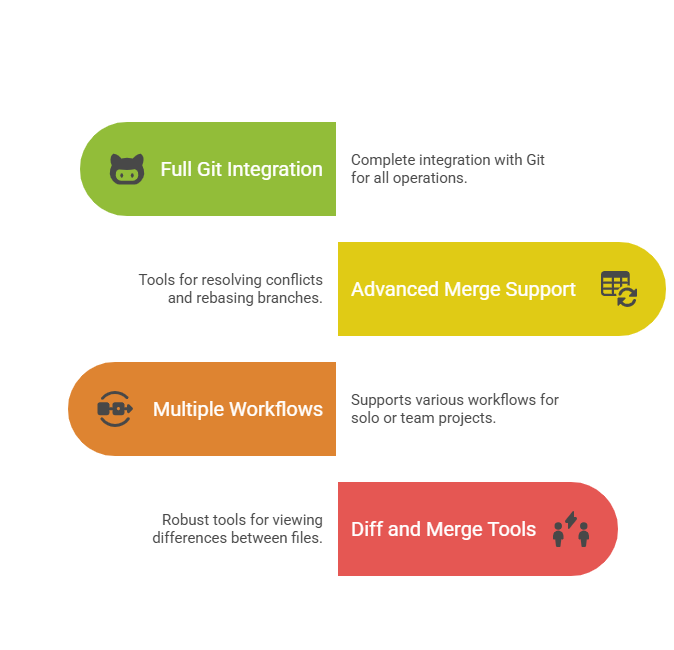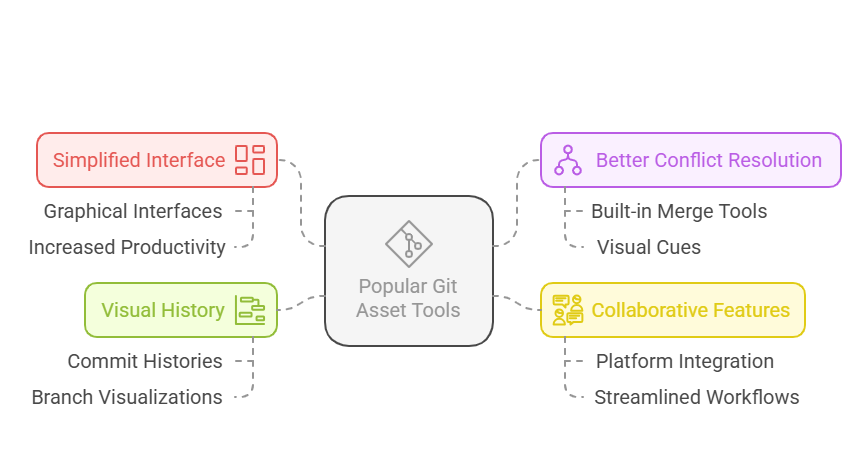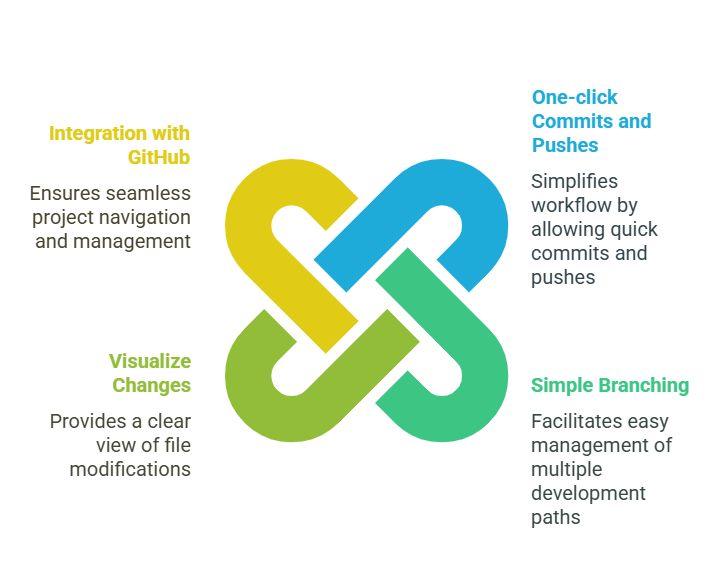Git has transformed how developers manage and collaborate on code, providing a powerful version control system that has become indispensable in today’s software development landscape. As you dive deeper into Git and your coding journey expands, it’s important to have the right tools to make your experience more seamless and efficient. This is where popular Git asset tools come into play.
In this guide, we’ll explore some of the most popular Git asset tools and how they can improve your workflow, streamline collaboration, and make version control easier to manage. Whether you’re working solo on a small project or part of a large development team, these tools will help you manage your Git repositories with greater ease and efficiency.
What Are Git Asset Tools?
Git asset tools are software solutions that enhance the functionality and usability of Git. Git is a powerful version control system, but using it effectively, especially with larger repositories and complex workflows, can be challenging without the right tools. Git asset tools are designed to simplify Git usage by offering:
- Visualizations of commit histories
- Better conflict resolution
- Enhanced repository management
- Streamlined collaboration with teams
These tools can make the process of managing code much easier by offering graphical interfaces, integrations with other platforms, and a variety of useful features for every type of Git user. Read More:
👍Get Popular Git Asset Lifetime Access!
Why Do You Need Popular Git Asset Tools?
If you’ve ever worked with Git directly, you know it can be quite powerful but also tricky, especially when dealing with large projects and many contributors. Here are some reasons why popular Git asset tools are essential:
- Simplified Interface: Git’s command line can be intimidating for new developers. Git asset tools provide user-friendly graphical interfaces (GUIs) that make Git operations more accessible.
- Better Conflict Resolution: Git asset tools often come with built-in merge tools to help resolve conflicts faster and with greater clarity.
- Collaborative Features: Some Git tools integrate with platforms like GitHub, GitLab, and Bitbucket, allowing better collaboration between team members, with features like pull requests and issue tracking.
- Visual History: Many tools offer visualizations of commit histories, branches, and merges, making it easier to understand the state of your repository at any given time.
The 6 Most Popular Git Asset Tools You Should Know About
Now that we understand what Git asset tools are and why they’re so valuable, let’s take a look at some of the most popular Git asset tools available today. Each of these tools brings unique features that can greatly improve your experience with Git.
1. GitKraken: A Top Choice for Visual Git Management
GitKraken is one of the most popular Git asset tools on the market, providing a sleek and user-friendly interface that makes Git management a breeze. It is designed to handle Git repositories for both individual developers and teams.
Key Features:
- Intuitive UI: GitKraken’s visual interface simplifies Git workflows by providing an easy-to-understand view of your repositories, branches, commits, and merges.
- Built-in GitHub, GitLab, and Bitbucket Integrations: Seamlessly integrate with your favorite Git hosting platforms and manage your projects directly from GitKraken.
- Drag-and-Drop Merge Conflict Resolution: GitKraken simplifies conflict resolution with a drag-and-drop interface, making it easier to resolve merge conflicts.
- Cross-Platform Support: Available on Windows, Mac, and Linux.
GitKraken stands out for its user-friendly design, which makes it suitable for both beginners and experienced developers. It’s a versatile tool for managing code repositories, offering features that cater to both solo developers and teams.
Statistics: GitKraken has been adopted by over 6 million users worldwide, making it one of the leading Git asset tools. (Source: GitKraken website)
2. Sourcetree: Powerful Yet Simple Git Management
Sourcetree is another popular Git asset tool that’s widely used by developers. It’s a free Git GUI tool from Atlassian, the same company behind Jira and Bitbucket. Sourcetree provides powerful features while remaining easy to use, even for beginners.
Key Features:
- Detailed Commit History: Sourcetree offers a detailed, visual history of commits, making it easier to track changes in your repository.
- Branch Management: With Sourcetree, you can easily create, manage, and merge branches with just a few clicks.
- Built-in Merge Tool: Sourcetree comes with an integrated merge tool that makes resolving conflicts simple.
- Git and Mercurial Support: Sourcetree works not only with Git repositories but also Mercurial repositories, making it versatile.
Sourcetree is particularly useful for developers working with both Git and Mercurial repositories. Its clean and intuitive interface is especially appreciated by those who need a bit of extra help with visualizing branches and commit history.
3. GitHub Desktop: Git Integration with GitHub
GitHub Desktop is the go-to Git client for developers working within the GitHub ecosystem. It’s perfect for those who primarily use GitHub for version control and want a simple interface to manage their repositories.
Key Features:
- One-click Commits and Pushes: Easily commit and push changes to your GitHub repositories with just one click.
- Simple Branching: GitHub Desktop makes it easy to create, manage, and switch between branches.
- Visualize Changes: View the changes made to your files with a simple, easy-to-understand interface.
- Integration with GitHub: As the official Git client for GitHub, it integrates seamlessly with GitHub’s platform for managing repositories, issues, and pull requests.
For developers heavily integrated with GitHub, GitHub Desktop offers a clean, easy-to-use interface that reduces the complexity of working with Git repositories directly from the command line.
👍Get Popular Git Asset Lifetime Access!
4. Tower: A Premium Git Client for Professionals
Tower is a premium Git client that caters to developers who need advanced features and are looking for a polished, professional tool. Available for both Mac and Windows, Tower’s comprehensive feature set is ideal for developers working on complex projects.
Key Features:
- Advanced Git Features: Tower supports advanced features like interactive rebase, advanced branching, and submodule management.
- Drag-and-Drop Support: Tower simplifies Git operations like merging and rebasing with drag-and-drop functionality.
- Visual Merge Tool: Resolve conflicts visually and quickly with Tower’s advanced merge tool.
- Integrated Workflow: Tower integrates with GitHub, Bitbucket, and GitLab, making it easy to manage repositories from various platforms.
Tower is perfect for developers working on larger projects with intricate workflows. While it’s a paid tool, the price is worth it for professionals who need an efficient and powerful Git client.
5. Git Extensions: A Flexible and Open-Source Git Tool
Git Extensions is a free, open-source Git client for Windows, Linux, and macOS. It’s a powerful tool that offers a range of features for developers who need flexibility and control over their Git workflows.
Key Features:
- Full Git Integration: Git Extensions integrates fully with Git, allowing developers to execute all common Git operations via a GUI.
- Advanced Merge and Rebase Support: Git Extensions comes with advanced tools for resolving conflicts and rebasing branches.
- Support for Multiple Workflows: Whether you’re working solo or in teams, Git Extensions supports a variety of workflows.
- Powerful Diff and Merge Tools: View differences between files and branches, and resolve conflicts with ease.
Git Extensions is highly regarded for its extensive features and is a great choice for developers who want an open-source, flexible Git client with many advanced options.

6. SmartGit: A Robust Git Client for Developers
SmartGit is another feature-packed Git client that is especially popular among professional developers. It provides a full range of features for managing Git, Mercurial, and SVN repositories.
Key Features:
- Cross-Platform: SmartGit is available for Windows, macOS, and Linux, making it accessible to developers on different platforms.
- Multi-Repository Management: Manage multiple repositories simultaneously within a single interface.
- Integrated Merge and Diff Tools: SmartGit offers comprehensive tools to help you compare and merge branches with ease.
- Support for Git, Mercurial, and SVN: Unlike other Git clients, SmartGit works with Git, Mercurial, and SVN repositories, making it versatile for developers who need to work with multiple systems.
SmartGit is especially useful for developers who work in diverse environments and require support for multiple version control systems.
Conclusion: Choosing the Right Git Asset Tool for You
Choosing the right Git asset tool depends on your specific needs, the size of your projects, and the complexity of your workflows. If you’re a beginner, tools like GitHub Desktop or Sourcetree may be the most accessible. On the other hand, if you’re a professional working with large teams and repositories, GitKraken or Tower might be a better fit.
All of these popular Git asset tools offer unique features that can help you manage your codebase more effectively. Whether you’re visualizing commits, resolving merge conflicts, or collaborating with teammates, there’s a Git asset tool for every workflow.
By using these tools, you’ll streamline your development process, increase productivity, and enjoy a smoother experience with Git.



